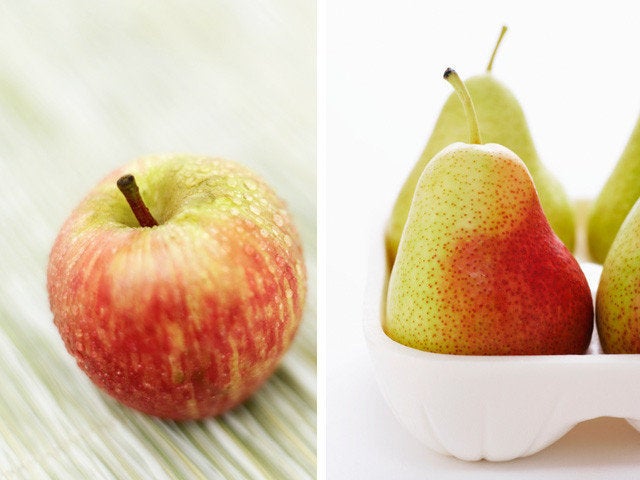
By Nadia Goodman for YouBeauty.com
Love handles or thunder thighs? No matter what you lovingly call your body fat, you probably experience one or the other. That’s because most women tend to gain weight in one of two places: Our waists or our hips. But what does this mean for your overall health? Pear-shaped women were long thought to have the health upper hand, but new research suggests apple-shaped women may not be out of luck. Read on for both sides of the story.
More from YouBeauty.com:
QUIZ: Scientifically Determine Your Body Type
QUIZ: Determine Your BMI and Waist-to-Hip Ratio
Dr. Oz and Dr. Roizen’s Tips to Improve Memory
THE BACKGROUND
When it comes to our body shapes, women have long been metaphorically (and rather inexplicably), compared to fruit. We’re “Apples” if we gain weight in our waists, and “Pears” if the pounds go straight to our hips and thighs.
These body shapes mean much more than deciding between an A-line or Empire wedding gown (the former works for Apples, the latter, for Pears). They’re a signal of our general health: Our bodies store different types of fat in our stomachs versus our thighs.
Those proverbial Pear thunder thighs are a good thing: Fat in our thighs stores energy that’s used during pregnancy and breastfeeding, so it’s commonly believed to be healthier. Abdominal fat, stored by Apples, doesn’t have a clear-cut purpose like thigh-fat, and releases chemicals that may increase inflammation in the body -- the root of many health and beauty-related evils, including heart disease.
For women, fat distribution actually shifts as we age. When we’re young, high levels of estrogen make us more likely to store our fat in our hips. After menopause, our levels of estrogen go down, and we start to store fat above the belt.
But are those of us born to store fat in our stomachs just plum out of luck for health? That’s where the research is debatable.
THE DEBATE
SIDE 1: Waist fat is bad for health.
In 2008, Japan launched a national health campaign mandating that companies and local governments measure waistlines as part of regular health check-ups -- with limits on maximum waist size (35.4 inches for women). Those who exceed the limit (the average American woman would) have three months to lose weight before they get mandatory dietary guidance, and companies are penalized if their employees don’t measure up.
Most physicians in the U.S. also measure waistlines (though we have no legal limits), and there’s a lot of research to support why they do.
A 2008 sixteen-year follow-up study published in Circulation found that waist fat was strongly associated with all-cause mortality, cardiovascular disease and cancer-related deaths. On top of that, they found that hip circumference was inversely associated with heart-related deaths, meaning that hefty hips may actually play a protective role.
Similarly, a study of almost 16,000 people with coronary artery disease found that central obesity (measured by waist circumference and waist-to-hip ratio) doubled the risk of mortality, even in those with a normal BMI (a measure of body fat). Another study found that waist fat is three times more strongly associated with heart disease than BMI.
Plus, numerous studies have shown that waist fat significantly increases the risk for diabetes, dementia and various other diseases. The body of research stacked up against waist fat is daunting and doesn’t paint a pretty picture.
SIDE 2: Waist fat is no worse than any other fat (and sometimes might be good!).
A small but growing voice is starting to challenge traditional wisdom.
A major study recently published in the Lancet upturned previous research, finding that waist fat doesn’t significantly increase health risks.
The researchers analyzed data from 58 studies involving 221,934 people. The findings showed that waist fat, when compared to BMI, is a roughly equal predictor of heart disease -- no better, no worse.
Unlike many previous studies, this analysis included only prospective studies (meaning ones that followed participants over time), which may have afforded more accurate results.
“Any fat accumulation is bad for health,” says lead author and epidemiologist David Wormser, MPhi. “But for clinicians, our study shows that measuring waist circumference or waist-to-hip ratio is no better for calculating a person’s cardiovascular risk than measuring BMI.” Instead, other measures like blood pressure, lipids and diabetes may be more accurate predictors.
A 2010 study from Northwestern University found that obesity is detrimental for memory and brain function, but that waist fat may actually be protective. Of the 8,745 post-menopausal women who participated in the study, those with pear-shaped bodies actually experienced more memory loss and cognitive decline, while women who stored weight in their waists stayed sharper.
Another study in the American Journal of Epidemiology found that abdominal fat increased the risk of age-related macular degeneration, but only in men. The opposite was true for women -- abdominal fat actually reduced the risk of early macular degeneration by up to 11 percent.
Most likely, any protective effects may have something to do with the type of fat stored in the stomach -- and the chemicals it releases.
The research is new, but it suggests that waist fat may not matter quite as much as we once thought.
THE MIDDLE GROUND
Like any other issue, body shape is complicated. But here’s what we do know: Being overweight or obese is harmful no matter where you store your weight.
Worrying about whether your body shape is better or worse isn’t worth your time -- the grass is always greener. Instead, focus on staying healthy. Tune in to how your body feels and how healthy it is inside, not just how it looks.
Eat well to feel good; stay active to face your day with energy; and practice mindfulness to feel sated and content with the life you have now. Loving your looks will be a bonus.